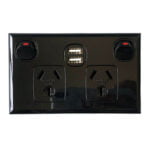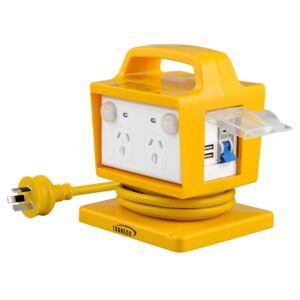A truly modern home is built to satisfy contemporary lifestyles. Technology that didn’t exist for most of the 20th century is now indispensable, and we need our homes to reflect that. While some big-ticket upgrades can be costly, adjustments like adding USB wall sockets can be comparatively inexpensive. If you’re looking for a simple and easy way to modernise your home, adding a USB power outlet can be a convenient solution.
Table of Contents
What are USB Power Outlets?
USB – or Universal Serial Bus – is a cable and connector system that allows for the flow of both power and information. Modern smartphones, laptops, and other technologies tend to use USB to charge power and communicate with each other. While one end of the cable often features proprietary technology (like Apple’s Lightning connector), USB connections themselves are standardised across the world.
USB power outlets add a USB connection port to the standard outlet faceplate we’re used to seeing in our homes. This means that USB cables can be plugged directly into the wall to charge, rather than needing a separate charging adaptor. Most USB outlets in Australia have two standard three-pin sockets, as well as two USB ports. USB outlets are already common in shared spaces such as airports and hotels, but they can provide great levels of convenience in the home too.
Do USB Outlets waste power?
Devices that are charged via USB draw power from whatever they are plugged into. If, for example, you’re charging your phone with a USB cable plugged into your laptop, you’ll be drawing charge out of the laptop. Taking power from one device to charge another is inefficient. Not only does charging this way rely on leaching power, but the power output of most devices is much lower than that of a wall socket. This means it takes longer to charge.
Using a USB power outlet allows devices to be charged with the same speed as power adaptors, but without the power flowing into the adaptor. When an adaptor is left in the socket unused, it still uses power (this is often felt as heat). With no adaptor required, the USB outlet does not heat up or continue to draw power when not in use.
Are USB Outlets Worth It?
USB outlets present a few advantages over traditional wall sockets. One of them is in the name – the connection is universal. If you’ve ever travelled overseas and forgotten to bring an adaptor, you’ll understand the frustration of being unable to charge your device. USB connections are standardised, and as such wall outlets do not require travel or charging adaptors.
Doing away with a charging adaptor, in general, is a good move. With many USB power outlets combining two three-pin sockets and two USB sockets, there are more power outlets available. Rather than overloading outlets with extended power boards, USB sockets allow devices to be charged directly. The relatively small profile of a USB port means saving on space, too. Wall outlets also have a greater power output compared to USB ports on most computers or other devices. This means a speedy charge that doesn’t take power from another device.
Are USB Wall Outlets Safe?
USB devices need adaptors to charge from traditional wall sockets. With an increasing number of USB-dependent devices in our lives, this can mean relying on power boards. The typical danger from a power board comes from overload – essentially, the power being drawn exceeds the maximum power available. This can result in damage to your devices, electrical shorts, and, potentially, fires. Rather than adding charging adaptors to overworked power boards, USB wall outlets take power directly. This means charging efficiently and safely.
Best USB Wall Socket from Transco Electrical
Like all power outlets, USB sockets come in a range of styles and sizes. The one that’s the best for you will depend on your interior style, the location of the outlet within your home, and your power requirements.
Glass-look OPAL with USB
The glass-look OPAL outlet is perfectly suited to modern living spaces. New apartments and homes with stainless steel and glass designs will fit particularly well with this design. The choice of black or white faceplate provides flexibility, while the push-button construction (rather than the traditional rocker switch) adds to the contemporary feel. Features two three-pin power outlets and two off-center USB outlets.
Extra Thin Slim Wafer with USB
From the front, the Slim Wafer has a traditional look. You get two three-pin sockets with standard rocker switches and two USB sockets in the middle. From the side, however, the profile is noticeably slimmer, sitting very low against the wall. The low profile means this outlet provides the convenience of USB and standard power access while remaining well-concealed.
Classic Double Pole with USB
The classic Powerclip double pole outlet has a traditional look, with a choice of black or white faceplate giving versatility. The two three-pin and two USB charging ports allow the flexibility of a modern outlet while retaining a classic outward appearance. This double pole GPO suits caravans, motorhomes, recreational vehicles, and other applications where double pole switching is required by law.
Portable Power Outlet RCBO Protected Pro with USB
The IP65 RCBO (RCD/MCB) protected Portable Power Outlet with USB is your investment in electrical safety, security, and convenience. It is designed to protect the user against electrocution and costly power tools from severe electrical damage. It combines protection against earth faults (such as when a live conductor is cut) as well as overloads and short circuits.
How to install USB wall sockets?
As tempting as it may be to buy and install a wall socket yourself, electrical work without a license is illegal. If you are unlicensed, call an electrician. It is always safer to engage the services of a professional rather than risk personal injury.
Installation of USB wall power outlets can be achieved with a screwdriver and a pair of pliers. First ensuring the power is turned off at the breaker. Take off the existing power point from the wall and remove the wires from their poles. You’ll notice the wire colours (generally red/brown is Active, black/blue is Neutral, green/yellow is Earth) all correspond to different poles on the power outlet. Take note of which colour wires correspond to which poles before detaching the wires. You will need to ensure the same pattern is replicated on the replacement USB power outlet. To attach the wires to their corresponding terminals, insert the wire firmly, and tighten the screw of the terminal. The screw should be firm, but not so firm as to break the wire. It should be tight enough to prevent the wire from coming loose.
Once you’ve reattached the wires and screwed the USB power outlet to the wall, turn the power back on. Your USB wall outlet will be good to go. But again, electrical work without a license is illegal so always call an electrician.
Still have questions? Our friendly and knowledgeable team is always available to help. Feel free to get in touch or request a quote at any time and we can help find the best USB power outlet for your needs.











